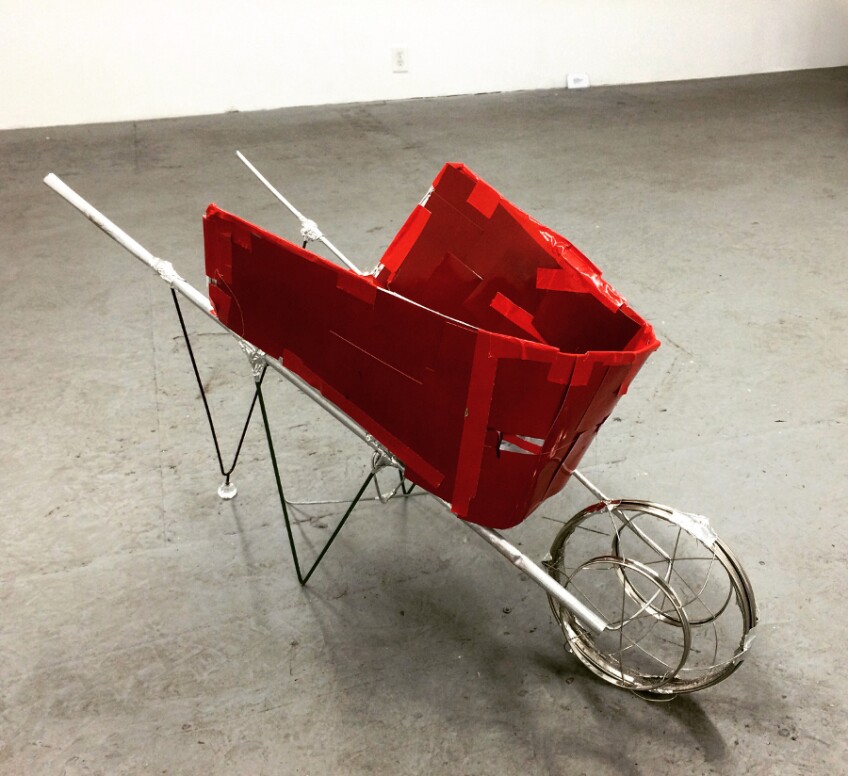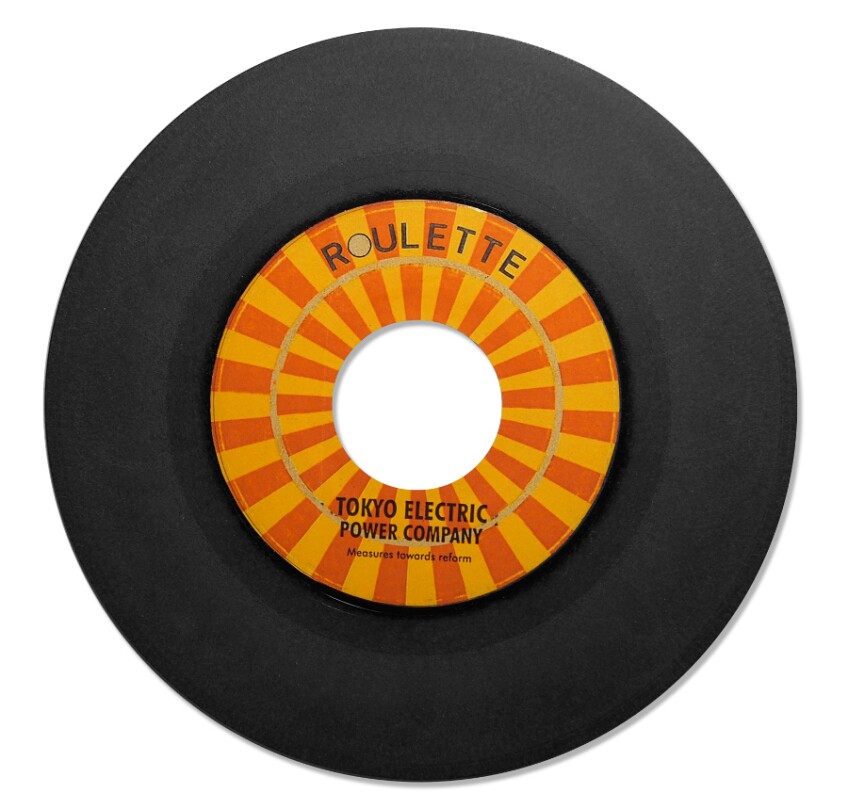Red Wheelbarrows and Whispering Rainbows: The Sonic and Visual Art of Kio Griffith


Asian Accents: This article is part of an ongoing series that explores the diverse range of artistic influences from Asia in the arts and culture of Southern California.
A work by Kio Griffith that was recently shown at the Durden and Ray Gallery in Downtown Los Angeles and the Coachella Valley Art Center and currently appears at the Torrance Art Museum in the exhibition "Doppelgänger" (April 2 to May 28, 2016) exemplifies the visual and sound artist’s cross-cultural, mixed media and multi-faceted approach to art. The work "Red Wheelbarrow," constructed from materials including Bakelite, photographic prints, a stainless steel strainer, is an assemblage tribute to William Carlos Williams’ 1962 modernist poem of the same name:
so much depends
upon
a red wheel
barrow
glazed with rain
water
beside the white
chickens.

Williams, whose parents were from two different cultures, had multiple careers, talents and interests, worked for decades as a physician before becoming one of the most innovative modern American poets. Griffith shares Williams’ bicultural heritage and his abundance of talent and energy, often combining multiple artistic modes and media in his work to create pieces like this “haikussemblage,” as he calls it, a poetic moment assembled from seemingly random objects and drawing from both Japanese traditional verse and modern Western modes of art. Inside his red wheelbarrow, he heaps hundreds of glossy red 4-by-6-inch photo prints and invites visitors to take one each. Holding the cards, which appear “glazed with rain,” visitors participate more intimately in Griffith’s artistic and poetic reference. “I’m playing on the idea of haiku being poetry of the moment. What they’re picking up is slightly after the moment, so there is a sense of the passage of time.”
Griffith, whose mother is Japanese and father is American of Welsh descent, has spent most of his life living between the U.S. and Japan. He studied art at Otis College of Art and Design in Los Angeles, and has worked for over 20 years as a graphic artist, designing among other things more than 300 album jackets. Based primarily in Los Angeles, he currently works as a visual and sound artist, graphic designer and producer, and his work -- in drawing, paintings, sound and video, performance, electronics, language, sculpture and installations -- has been shown widely in Japan, Hong Kong, Korea, Turkey, Belgium and the U.S., and he has performed widely musically, including as the guest composer for the opening of the Broad Contemporary Art Museum at the Los Angeles County Museum of Art. He also curates several exhibitions a year and is project director at TYPE (Tokyo+Yokohama Projects Exchange), curator and development director at ARTRA and curates regular exhibitions at the Japan Foundation’s Los Angeles office on Wilshire Boulevard. He is also associate editor at Fabrik and Artillery magazines and art director at Angel City Jazz Festival.

Much of Griffith’s work as a visual and sound artist involves research into the specific sonic and visual transformation of history, myth, geographic locations, documentation and time. Using a range of materials and media for his sound sculptures, installations, audio and visual recordings, crowd sourcing, and live performances, he strives to create “new narrative representations that search for clues in which truisms are deconstructed, rearranged and orchestrated into an immersive social experience.” In his series "Revolutions Per Minute," which he began in 2013, he featured a series of 7-inch vinyl records, replacing the original labels with bold social and political commentaries and eradicating the original song to leave rhythmic static recordings. Displayed together as an installation, the records form a display of imagined manifestos of art, political movements and corporations that exert a tremendous impact on our lives and habitat.
For one of these records, Griffith reproduced the design of a 1960s Arctic Record Company record label, substituting the artist’s name with British Petroleum and the song title as “We Are BP,” with the subtitle, “We care deeply about how we deliver energy to the world.” The record’s original sound has been transformed into a one-minute long explosion of static, leading with a powerful boom suggestive of the 2010 rupturing of BP’s Deepwater Horizon oil well in the Gulf of Mexico. Of course, the controversial matter of drilling for oil in the Arctic is also referenced. In another record by “Roulette,” the song is “Tokyo Electric Company,” subtitled, “Measures towards reform,” a direct reference to the nuclear disaster at the company’s Fukushima Daiichi Nuclear Plant during the 2011 Tohoku earthquake and tsunami. The record label design is particularly striking -- at once a roulette wheel implying Russian roulette and risk and the red rays of the sun in Japan’s wartime hi no maru flag.

In a current artistic project, Griffith is exploring voice, sound, and language in relation to our responses to color. Selected as one of 80 artists for the third Aichi Triennale in Nagoya, Japan, in August 2016, Griffith is creating a “pan-national and “pan-sensory” installation called "White House." For the installation, he will coat the walls and floor of a gallery in the Aichi Art Center with gray felt, in a range of tones that suggest different values of color that may have once been there but have disappeared. The gallery will be empty except for a standing speaker at the center and 200 or so speakers mounted along the walls above a railing. He is collecting hundreds of short voice recordings of people reading verses or phrases about particular colors, borrowed, or “resurrected” from lost novels, poetry, song lyrics in different languages and dialects, with the aim of “breathing new life into what may be lost in generational transference.” Grouping these readings according to color, Griffith plans to use the multitude of diverse tones and tempos as notes to create a sonic composition, which will be fed softly through the small wall speakers at different rates and rhythms, creating a rainbow of whispers that will guide visitors through the space.
“Visitors will walk along the edge of the gallery in the low light, holding onto a railing,” he explains. “They will listen to the voices talking in various languages, like a symphony, and they will find a sound or message or experience that appeals to them. If they have the courage to navigate through the dark to the center of the space, they will discover a final, special message.” For the duration of the installation, which will run from August through the end of October, Griffith plans to add new voices, allowing the installation to grow like a living organism, an “immersive social communal experience” that will encourage people to slow down, listen carefully and contemplate the myriad colors and connections of our lives.

Kio Griffith is planning to create a version of the "White House" installation in Los Angeles in 2017 and is continuing to collect recordings. Anyone interested in participating in this project can contact the artist via his website. Information about his upcoming exhibits and performances can also be found there.
Top image: Kio Griffith, "Revolutions Per Minute," 2015. Eradicated 7-inch vinyls, labels, sleeves, one-minute audio. | Photo: Courtesy of the artist.